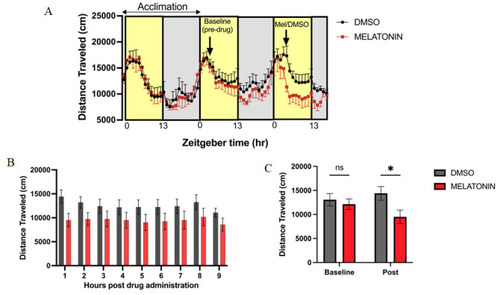- Title
-
Measuring Sleep and Activity Patterns in Adult Zebrafish
- Authors
- Doldur-Balli, F., Zimmerman, A.J., Seiler, C., Veatch, O., Pack, A.I.
- Source
- Full text @ Bio Protoc
|
Video monitoring system to measure locomotor activity patterns in juvenile and adult zebrafish. The experimental system is composed of the Zebracube system (ViewPoint Life Sciences, Inc.), a camera located at the top of the equipment to capture locomotor activity data of zebrafish, a water bath for circulating warm water during experiments, a regulator, and a temperature control unit. In and out pipes for water circulation are marked on the picture. |
|
Adult zebrafish activity monitoring assay. The swimming behavior of six adult zebrafish is monitored in separate tanks. Large movement, small movement, and inactivity can be tracked. |
|
Tools in the software to specify the virtual areas (rectangular icon marked with purple circle) for collecting activity data of adult zebrafish and to apply distance calibration (ruler icon marked with black circle). Location name needs to be changed with each box to provide a unique identifier in the output file. Make sure to keep a note of which genotype/treatment is in each location. Each location is identified as Loc1–6 to differentiate each animal. |
|
Stimulus driving tab to define light and dark cycle. We specified 13 h of light cycle starting at 07:45 am and 11 h of dark cycle starting at 8:45 pm to be consistent with the light settings at the core facility. Time of lights on and duration of light and dark cycle may be redefined in the software. Make sure to test the light source with a lux meter at the level of the tanks to ensure consistent lux readings across experiments. Alterations in brightness and hue can alter behavior. Select the option loop until the software is closed to keep the same light/dark cycle until the end of the experiment. |
|
A representative output Excel spreadsheet showing locomotor activity record of adult zebrafish. To analyze the data, we created a new variable called “sumdist,” which is the sum of the activity in the “smldist” and “lardist” columns. Small movement distance (smldist) and large movement distance (lardist) are calculated by the software using the determined thresholds. |
|
Exogenous melatonin decreases daytime wakefulness. A. Distance traveled (mean and SEM) captured across three continuous days. Melatonin (150 µM final concentration in 0.3% DMSO) or 0.3% DMSO (control) was administered at 11:45 am (right arrow). Activity is captured on a 13:11 h light/dark cycle and shown as zeitgeber time. B. Total distance traveled each hour of light cycle following drug administration. C. Total distance traveled in the hour following drug administration (12 pm–1 pm). Two-way RM-ANOVA with Bonferroni’s multiple comparisons test was performed in B–C. *p < 0.05 adjusted. Data are presented as mean and SEM. n = 8 fish/group from three biological replicates. |






